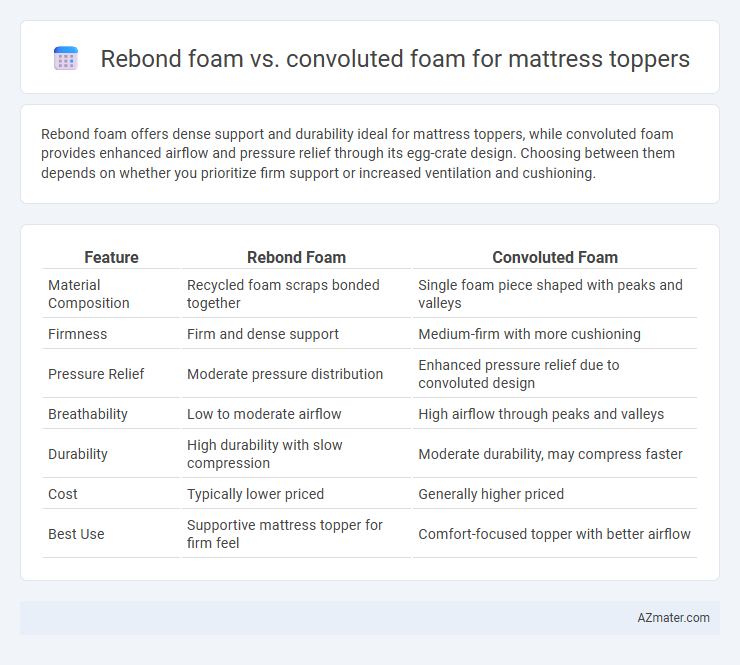Rebond foam offers dense support and durability ideal for mattress toppers, while convoluted foam provides enhanced airflow and pressure relief through its egg-crate design. Choosing between them depends on whether you prioritize firm support or increased ventilation and cushioning.
Table of Comparison
| Feature | Rebond Foam | Convoluted Foam |
|---|---|---|
| Material Composition | Recycled foam scraps bonded together | Single foam piece shaped with peaks and valleys |
| Firmness | Firm and dense support | Medium-firm with more cushioning |
| Pressure Relief | Moderate pressure distribution | Enhanced pressure relief due to convoluted design |
| Breathability | Low to moderate airflow | High airflow through peaks and valleys |
| Durability | High durability with slow compression | Moderate durability, may compress faster |
| Cost | Typically lower priced | Generally higher priced |
| Best Use | Supportive mattress topper for firm feel | Comfort-focused topper with better airflow |
Overview of Rebond Foam and Convoluted Foam
Rebond foam is created by shredding scrap polyurethane foam and bonding it together with adhesives, resulting in a dense and highly supportive material ideal for mattress toppers that require durability and firm pressure relief. Convoluted foam, also known as egg crate foam, features a textured surface with peaks and valleys designed to enhance airflow and provide targeted cushioning, making it suitable for users seeking improved breathability and gentle contouring. Both foams serve distinct purposes: Rebond foam excels in strength and longevity, while Convoluted foam prioritizes ventilation and comfort modulation.
Key Material Differences
Rebond foam is made by compressing shredded scrap foam pieces into a denser, firmer material, offering high durability and support ideal for those needing extra cushioning with a firm feel. Convoluted foam, commonly known as egg crate foam, features a textured surface with peaks and valleys to enhance airflow and pressure relief, making it softer and more breathable compared to rebond foam. The primary material difference lies in rebond foam's recycled composite structure versus convoluted foam's uniform, open-cell polyurethane design optimized for ventilation and contouring.
Durability and Longevity Comparison
Rebond foam mattress toppers offer superior durability due to their dense composition made from shredded foam scraps fused together, resulting in long-lasting support that resists sagging and deformation over time. Convoluted foam, characterized by its egg-crate design, provides excellent breathability and pressure relief but tends to compress faster under regular use, reducing its longevity compared to rebond foam. For consumers prioritizing extended mattress topper lifespan, rebond foam is a more resilient option with enhanced structural integrity.
Support and Pressure Relief
Rebond foam offers solid, dense support ideal for mattresses requiring firmness and durability, while convoluted foam provides enhanced pressure relief through its egg crate design that promotes airflow and reduces pressure points. Convoluted foam's unique surface contouring allows better weight distribution, making it suitable for individuals needing targeted comfort and pressure management. Rebond foam excels in structural support but may lack the softness and breathability found in convoluted foam toppers.
Comfort and Sleep Quality
Rebond foam offers firmer support and durability, ideal for individuals needing pressure relief and spinal alignment, enhancing sleep quality through consistent firmness. Convoluted foam, characterized by its egg-crate design, provides superior airflow and contouring comfort, reducing heat retention and improving comfort for those prone to overheating during sleep. Choosing between rebond and convoluted foam depends on preference for support versus breathability, both significantly impacting overall sleep comfort and restfulness.
Breathability and Temperature Regulation
Rebond foam offers moderate breathability due to its dense and firm structure, which can retain heat more than convoluted foam, potentially impacting temperature regulation during sleep. Convoluted foam features an egg-crate design that enhances airflow, promoting superior breathability and better temperature control by dissipating heat more effectively. For mattress toppers emphasizing cooling and air circulation, convoluted foam generally outperforms rebond foam in maintaining a comfortable sleeping environment.
Motion Isolation Capabilities
Rebond foam provides excellent motion isolation due to its dense and supportive structure, effectively absorbing movement and minimizing disturbance across the mattress surface. Convoluted foam, characterized by its egg-crate design, offers moderate motion isolation but primarily enhances airflow and pressure relief rather than minimizing motion transfer. For sleepers prioritizing reduced motion disturbance, rebond foam mattress toppers deliver superior performance compared to convoluted foam options.
Suitability for Various Sleep Positions
Rebond foam offers firm support and durability, making it ideal for back and stomach sleepers who require consistent spinal alignment and pressure relief. Convoluted foam features a unique egg-crate design that enhances airflow and provides gentle cushioning, benefiting side sleepers by reducing pressure on shoulders and hips. Both foams cater to different sleep preferences, with rebond foam suited for those needing firmer support and convoluted foam favored for its softer, contouring comfort.
Cost and Value Analysis
Rebond foam generally offers a lower cost per square foot compared to convoluted foam, providing a budget-friendly option for mattress toppers without compromising essential support. Convoluted foam, with its egg-crate design, enhances airflow and pressure relief, delivering higher value for those prioritizing breathability and comfort despite its higher price point. Evaluating long-term durability and individual sleep preferences is crucial for determining the optimal balance between upfront cost and overall value in mattress topper investments.
Choosing the Best Foam for Your Mattress Topper
Rebond foam offers high-density durability and firm support, making it ideal for those seeking enhanced spinal alignment and pressure relief. Convoluted foam features an egg-crate design that promotes superior airflow and cushioning, perfect for individuals wanting increased breathability and softness. Selecting the best foam depends on personal comfort preferences and specific mattress needs, with rebond foam suited for durability and firmness while convoluted foam excels in ventilation and gentle contouring.

Infographic: Rebond foam vs Convoluted foam for Mattress topper
 azmater.com
azmater.com